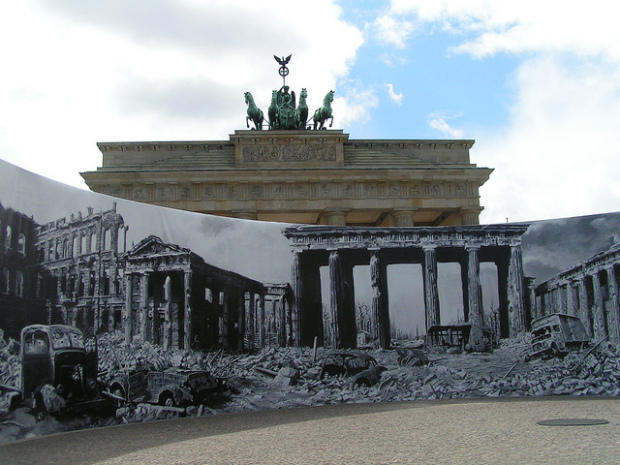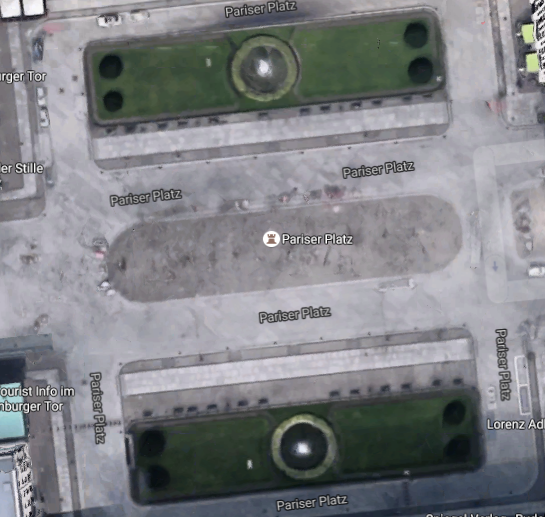Introduction
There are many interesting places to be visited in Berlin. Each site has its history and impact on the country. Unfortunately, several tourists pay their attention to the places that are defined by their guides and neglect the beauty and importance of small places or the places with a little historical significance. The story of Pariser Platz is rich and profound, but it is usually confused or combined with the history of the Brandenburg Gate located left of the square’s center. This paper aims at discussing the architectural peculiarities of Pariser Platz, the square in the center of Berlin that was created at the beginning of the 1730s, destroyed during the years of the World War II with the only structure left, and rebuilt with time to become the symbol of separation and unification of the people of Berlin.
Historical Context
The history of Pariser Platz began in 1732. At the beginning and during almost the next century, the place was known as an ordinary square with its goal to symbolize the external borders of the city. It did not have a name. Regarding the expansion of the city, the location of the square was changed. After several years of expansion, the square turned out to be the center of the city.
In 1814, it finally got its name in honor of Napoleon’s defeat and the occupation of Paris by the existed anti-Napoleon allies. It was not the center of the city only. At that moment, it was the symbol of the power of the country and the unity of its people. Pariser Platz attracted the attention of many people and created the need to develop as many buildings as possible at the square to underline their importance and roles for people. For example, at the square, embassies of America and France were located. Besides, it was the location of one of the most beautiful and impressive hotels in Berlin. Finally, there was the Academy of the Arts. The form of the place was effective indeed and made the location of many offices and buildings possible without considerable changes. However, the outcomes of the World War II were tragic for Pariser Platz because air forces of the enemies destroyed all buildings:

The only things that left were the form of the square and the Brandenburg Gate. With time, the Berlin War was built next to Pariser Platz, and the square was abandoned for years. It was isolated. In 1990, Berlin was reunited, and the Wall was destroyed. In a moment, Pariser Platz turned out to be the place where people from different parts of the city could meet each other and share their experiences. The historical overview proves that Pariser Platz could be defined as the symbol of hope and a union of the people of Berlin.
Ladd’s Evaluation
In the book chosen for the analysis, not much attention is paid to Pariser Platz. Ladd did not find it necessary to say a lot about the chosen site. Such a decision could be explained by the recognition of the Brandenburg Gate as the main sight of the city. Pariser Platz is not a building or a sculpture to be discovered. It is the place where a lot of events occurred, and many significant buildings were created. The description of each building or architectural site located at the square or close to it includes the reference to Pariser Platz anyway.
Writing about Pariser Platz, Ladd mentioned that though it was one of the elegant squares in the world, it was desolated for years, and the reason for such desolation was the Wall. The point is that Ladd wrote the book in 1989. At that period, Pariser Platz was forgotten because of the Wall. People knew something about Pariser Platz only from books or other academic sources. Not much information or personal opinions could be used to explain the beauty of the place and its functionality. If Ladd created the book in ten years, more information could be developed about that square.
Personal Observations
Nowadays, Pariser Platz could be identified with ease on the map. First, it is located at the center of the city, and second, it is close to the place where the two parts of the country were divided:

Its forms and location attract the attention of many tourists and local citizens. There is much space to take a rest. At the same time, the square is surrounded by several impressive buildings that create some kind of protection and unity. Though many people are in a rush at that square, it is possible to find a moment and enjoy the beauty of the place, its peacefulness, and the sense of freedom. Though it has certain boundaries and measurements, the visitors of the square could enjoy the beauty of open-air and freshness. It does not matter if the square is observed in the morning or at night, in summer or during winter holidays, the number of people is almost the same except the cases when some social events take place there.
The citizens of Berlin, as well as the Germans from other cities, are proud of Pariser Platz and its history. The square is usually compared to the essence of Germans. In the beginning, it was nameless and aimed at the creation of boundaries for the inhabitant. With time, it became one of the most significant sights of the city. Because of numerous war conflicts, it was destroyed. Still, the core of the square was not removed. It helped Pariser Platz to be rebuilt and introduced to new generations as a significant historical contribution. In other words, Pariser Platz seems to be a kind of reflection of the German spirit developed through centuries.
Besides, there is an impressive green zone next to the Pariser Platz. People could enjoy the impressive buildings introduced at Pariser Platz and then get a chance to observe the natural achievements of the city. The contrast is impressive indeed. Still, there is one thing that remains to be the same – Pariser Platz, as well as other places in Berlin, is characterized by an appropriate order. There is no extra thing or building at the square. People know where to find something or whom to address for the help in case some uncertainties take place.
Possible Changes
Taking into consideration the history of the place, the possibilities of the Germans to build and re-build the square, and the intentions to save the historical sites, it is possible to say that Pariser Platz could observe some changes with time. However, the majority of changes should have clear reasons and explanations. There is no need to change the size of the square or improve its functionality. Pariser Platz has a perfect size. It is protected by several buildings around. There is enough space to invite thousands of people at the same time. For a long period, the square was a part of federal roads. Still, the corrections were made. Now, only public transport and bicycles could be observed at Pariser Platz. Therefore, the changes could be offered in terms of illumination that could attract people and make them feel comfortable 24/7.
One of the possible recommendations for designers is to focus on ground lights. It could be interesting and impressive to observe Pariser Platz at night when several street lights were directed to the sky.
Conclusion
In general, the evaluation of Pariser Platz, its history, and changes helped to understand the story of Germany. Regardless of numerous challenges and trials Pariser Platz survived during the last two centuries and proved what it means to be the center of the city, the place where unification could happen, and the square where peace, confidence, and pride could be discovered by every visitor. Pariser Platz is not just an ordinary square in the city that symbolizes its core. It is the way of how the country was living and developing during the last several centuries. Wars, conflicts, the inabilities to solve problems, etc. could prevent the possible fast development of the square and its contribution to people, the government, and history. Some people may recognize Pariser Platz as not a perfect architectural site with a few significant events at it. Still, many Germans, who know their history and respect the achievements of their grandparents, understand that Pariser Platz is the symbol of the citizens of Berlin, their beliefs, and power.
Bibliography
Ladd, Brian. The Ghosts of Berlin: Confronting German History in the Urban Landscape. Chicago: University of Chicago Press, 2008.
“Pariser Platz.” Google Maps. Web.
Voights, Matt. Berlin, Part One: 1945, by Way of 2005. Web.